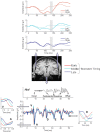Auditory brainstem timing predicts cerebral asymmetry for speech
- PMID: 17065453
- PMCID: PMC6674666
- DOI: 10.1523/JNEUROSCI.2744-06.2006
Auditory brainstem timing predicts cerebral asymmetry for speech
Abstract
The left hemisphere of the human cerebral cortex is dominant for processing rapid acoustic stimuli, including speech, and this specialized activity is preceded by processing in the auditory brainstem. It is not known to what extent the integrity of brainstem encoding of speech impacts patterns of asymmetry at cortex. Here, we demonstrate that the precision of temporal encoding of speech in auditory brainstem predicts cerebral asymmetry for speech sounds measured in a group of children spanning a range of language skills. Results provide strong evidence that timing deficits measured at the auditory brainstem negatively impact rapid acoustic processing by specialized structures of cortex, and demonstrate a delicate relationship between cortical activation patterns and the temporal integrity of cortical input.
Figures



References
-
- Ahissar M, Hochstein S. The reverse hierarchy theory of visual perceptual learning. Trends Cogn Sci. 2004;8:457–464. - PubMed
-
- Belin P, Zilbovicius M, Crozier S, Thivard L, Fontaine A, Masure MC, Samson Y. Lateralization of speech and auditory temporal processing. J Cogn Neurosci. 1998;10:536–540. - PubMed
-
- Carrell TD, Bradlow AR, Nicol TG, Koch DB, Kraus N. Interactive software for evaluating auditory discrimination. Ear Hear. 1999;20:175–176. - PubMed
Publication types
MeSH terms
Grants and funding
LinkOut - more resources
Full Text Sources
Other Literature Sources
